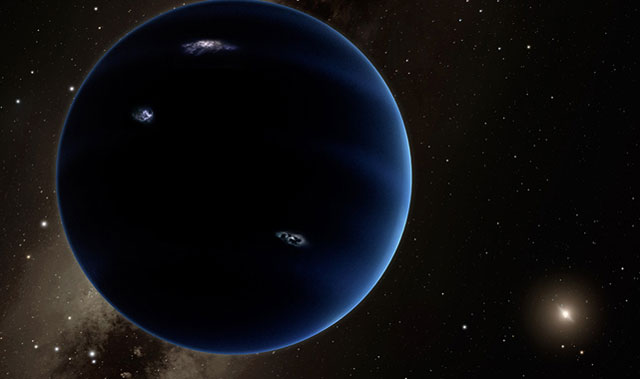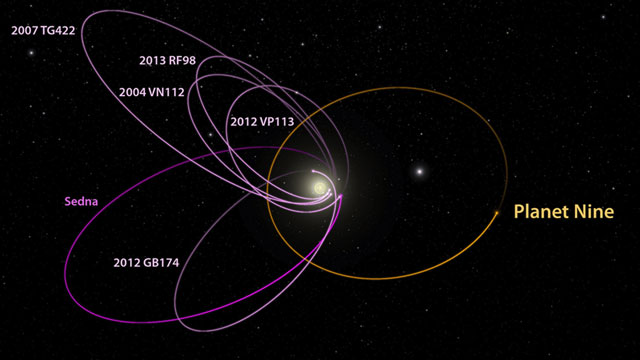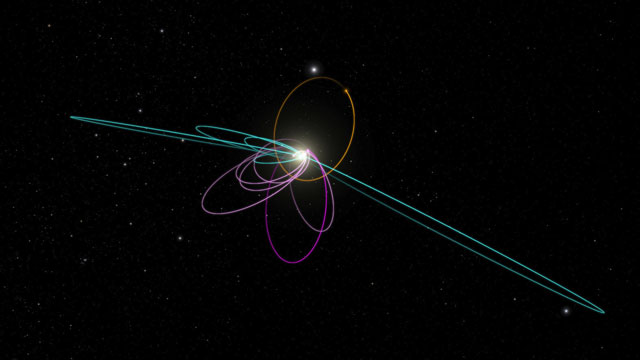
There’s plenty of excitement at the announcement overnight that a new planet is potentially waiting to be found at the extremes of our solar system.
The possible ninth planet is thought to be quite substantial, with a mass around 10 times that of Earth and a radius that’s two to four times bigger. This characterises it as a Neptune-like object.
What’s truly remarkable about Planet Nine, as it has been dubbed, is its very long orbit. It is estimated to take between 10 000 to 20 000 years to orbit our sun, on an elliptical orbit that stretches way beyond the Kuiper Belt.
The Kuiper Belt is a ring of icy objects (which includes Pluto) that circles the sun beyond the orbit of Neptune. Neptune orbits about 30 times further from the sun than the Earth and astronomers refer to Neptune’s distance from the sun as being 30 astronomical units (au) (where one au is the Earth-sun distance). Pluto follows an elliptical orbit that brings it as close as 29,7au from the sun, then out to almost 50au at its most distant point.
Planet Nine’s proposed elliptical orbit takes it from 200au at its closest to the sun (or perihelion) and between 500au to 1 200au at its furthest (aphelion). When it comes in close, it should be bright enough for high-spec backyard telescopes to pick it up.
But unfortunately, most of the time the planet will be much more distant and that represents a greater challenge. It will require the world’s largest telescopes, such as the 10m diameter Keck telescopes and Japan’s 8,2m Subaru telescope (both located on Mauna Kea in Hawaii) to have a hope of seeing it.

But the planet has yet to be seen. So why is it thought to be out there? And how can we know so much about it? Planet Nine is the best fit to explain the orbits of six distant objects.
What’s odd about these six objects is that they have peculiar but remarkably similar orbits. These objects have been nudged off kilter and yet they are all shepherded together in the same region of space.
The first of these objects to be discovered was Sedna. It was observed in 2003, as it approached perihelion. When its 11 400-year orbit was calculated, the discovery team realised that this object was orbiting in a kind of “no-man’s land” (or more correctly “no-person’s land”).
It was too distant to belong to the Kuiper Belt and not far enough away to be among the sphere of comets orbiting the sun in the Oort Cloud.
Sedna was also beyond the gravitational pull of Neptune, so something else, perhaps a large planet or possibly even a passing star (one of the sun’s many siblings perhaps), might have nudged it off course. What makes Planet Nine feasible is that it can explain the orbit of Sedna along with the other five objects.
At their closest approach to the sun, these six objects sit within the plane of the solar system. Planet Nine would have an orbit that is anti-aligned to the six objects and provides the gravitational tug needed to keep those planets in check.
And there’s more. What makes good science is when a proposed model explains something above and beyond its original intention. Simulations of Planet Nine predict that there should also be objects in the Kuiper Belt that have orbits perpendicularly inclined to the plane of the solar system.
Turns out, these objects exist. Five such objects have been known about since 2002, although their orbits have been unexplained until now.

Haven’t we seen this before?
If Planet Nine does exist, it’s not the first time that a planet in our solar system has been discovered theoretically before being directly observed. In 1845, deviations in the orbit of Uranus suggested there might be an eighth planet to the solar system and in 1846, Neptune was observed exactly where it was predicted to be.
There have also been predictions that haven’t stood the test of time. Back in the 1980s, scientists proposed that the sun might be a binary, with a dim undiscovered companion moving along on elongated orbit. Every 23m years (or so), this star named Nemesis would pass through the solar system causing a deluge of comets to impact Earth and produce mass extinctions.
More recently, around the turn of the millennium, astronomers noticed an asymmetry in the distribution of new comets coming in from the Oort Cloud. In theory, comets should come evenly from all directions, but there was a slight excess distributed around a great circle on the sky. One of the explanations was that there could be a Jupiter-mass planet in the Oort cloud, known as Tyche.
In 2014, Nasa’s Wide-Field Infrared Survey Explorer (WISE) examined the entire sky across infrared wavelengths. It was the perfect telescope to detect Nemesis or Tyche, but failed to find any evidence of either.
Will we find Planet Nine?
Scientists are sceptical by nature. It’s exciting to have a model that predicts the existence of Planet Nine, but this prediction must also be tested.
Astronomers have begun searching through astronomical surveys, such as the WISE survey, the Catalina Sky Survey and the Pan STARRS surveys in the hope of making a sighting.
So far, nothing has been seen. The conclusion, as described in a blog by astronomer Mike Brown (who proposed Planet Nine along with colleague Konstantin Batygin) is that if it exists, it is likely in the hardest place to find.
It seems to currently be at its furthest point from the sun, at least 500au away; it’s probably fainter than 22nd magnitude (that’s 1 500 times fainter than Pluto); and very possibly it’s aligned with the plane of the Milky Way Galaxy (meaning that Planet Nine may currently be hidden against the background stars of our galaxy).
Regardless, the hunt is on and there just may be a great discovery out there, waiting to happen.![]()
- Tanya Hill is honorary fellow of the University of Melbourne and senior curator (astronomy) at Museum Victoria; Jonti Horner is vice chancellor’s senior research fellow at the University of Southern Queensland
- This article was originally published on The Conversation

